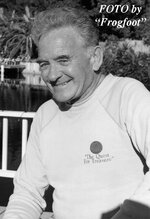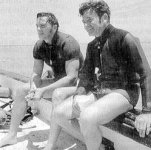GOIN E. “JACK” HASKINS
18 December 1927 - 11 September 2012
Jack was born in Montpelier, VT, on December 18, 1927, almost 85 years ago and spent his young years there. One day a barnstormer landed at the airport in Montpelier and Jack was immediately hooked on flying. But he went to sea before he got up in the air.
On his 16th birthday, Jack went into the Navy. He was sent to the US Naval Training Station at Sampson, NY on January 25, 1944, and spent three months there. His first tour of duty was at the Motor Torpedo Boat School at Melville, RI, and he was assigned to the USS Biddle (DD151) in February 1945. While on board, he saw action against the U-853, a Nazi submarine off Block Island, NY, which was one of the last Nazi ships to be sunk in WWII. After the war was over the Biddle was scrapped, and Jack was transferred to the USS Tennessee (BB43) for a short time. Jack would always say that he went from the smallest fighting ships in the Navy to one of the biggest.
After spending a year at sea, he finally got up in the air. In 1946 - 1947 Jack took his flight training at Bedford Army Air Force Base in Bedford, MA eventually earning a commercial and instructor’s license, as well as a helicopter instructor’s license. From 1947 to 1967 Jack was a corporate pilot flying twin engine propeller aircraft. He flew for Bendix Corp. for eight years, and then for Bill Strube, a man who bought and sold military surplus all over the country. It was on one of these trips in 1965 that Strube took Jack to Padre Island, TX to do some treasure diving. Jack found his first coin there (1554 Fleet) and knew he’d found his life’s calling. In 1967 Jack ended his flying career after a close call in bad weather.
He moved to the Keys and started treasure diving on a full-time basis. He bought a boat and named it the “Trident”. Jack successfully salvaged treasure from the 1715 and 1733 fleets, the Concepción (Dominican Republic) and the San Josef (Panama). He personally recovered significant quantities of Spanish gold and silver, including the famous Haskins medallion on the 1733 Capitana (which the late Mendel Peterson said was the most significant artifact found on the 1733 Fleet). Jack located the log of the Henry, which was the key to pinpointing the Concepción off the coast of Hispaniola…and then was the first person to find treasure on the wreck site.
But Jack was a lot more than a salvor. Despite an erratic formal education, he was a respected Spanish shipwreck scholar, researcher, and Spanish colonial numismatist. He taught himself to read Spanish … and then Archaic Spanish. Then he spent the best part of two years in the archives in Seville, Spain, copying and translating every document related to Spanish shipwrecks in the Caribbean. As such, Jack was consulted on virtually every shipwreck salvage project in the Caribbean during the past 20 years.
It was while he was in Seville that he first started researching the San Josef, which foundered off the west coast of Panama in 1631. Based on his research, in 1988 Jack led a group of investors down to Panama to search for it. On the first day he anchored his Zodiac over where his research indicated it was located, dove in, and found a silver bar from the wreck within 50 feet of the anchor! No one has ever located an ancient shipwreck with such accuracy…or as quickly. Much to Jack’s disappointment, the San Josef has never been salvaged due to the shipwreck politics in Panama …but we’re hopeful that Jack’s business partners will eventually be able to salvage the wreck and build a museum in Jack’s honor.
Jack was from the “old guard” of treasure hunters … a gentlemen first and treasure hunter second. He was universally respected and trusted by all; even the government officials knew they could take Jack at his word. Jack was from the era when one treasure hunter respected another treasure hunter’s wreck and the Florida Marine Patrol was a friend to all the divers.
Most of all, Jack was a friend to all of us in the treasure community… and an excellent sounding board for our next treasure quest. Jack outlived all of his family members…but leaves a multitude of friends behind.
Jack’s wishes were to be cremated, with half of his remains buried in the family cemetery plot in Cambridge, VT, and the other half put on the 1733 Capitana where he spent many happy days treasure diving. Carl Fismer and Dave Crooks will see that his wishes are honored.
“He was a true leader in the world of shipwreck exploration and research…and his contributions have been legendary.” – Greg Stemm, Odyssey Marine Exploration
Thanks, Jack, for your friendship, advice, humor, and scholarly contributions to Spanish shipwreck salvage.

--Dave Crooks
Last edited:



